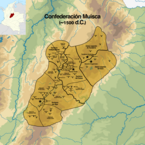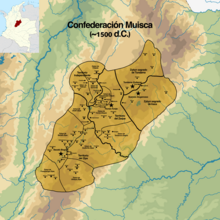Meicuchuca
| Meicuchuca | |
|---|---|
| Zipa of Bacatá | |
 portrait of Meicuchuca, by: Andrés Camilo Bohórquez Roa | |
| Zipa of Bacatá | |
| Reign | c. 1450 – 1470 |
| Predecessor | Menquetá |
| Successor | Saguamanchica |
| Nephew | Saguamanchica |
| Born | unknown Bacatá, Muisca Confederation |
| Died | c. 1470 Bacatá, Muisca Confederation |
| House | Bacatá |
| Religion | Muisca religion |
Meicuchuca (died 1470) was the first ruler (zipa) of Bacatá, as of around 1450. His zaque counterpart ruling over the northern area of the Muisca territory was Hunzahúa.
Biography
Little is known about Meicuchuca and many stories about his reign are more mythical than historical. He ruled the southern Muisca territory from around 1450 to 1470 and was succeeded according to Muisca heritage laws by his nephew Saguamanchica.
Meicuchuca and the snake
The legend of Meicuchuca and the snake tells the story of the zipa who already had many wives. Polygamy was common practice with the Muisca and the higher the rank, the more wives could be held. The highest position of zipa could allow to have and sustain 300 wives, while the lower rank cacique "only" made 100 wives possible.[1]
Meicuchuca allegedly fell in love with a woman outside of the Muisca community. He only had eye for her and spent day and night with the beautiful stranger, forgetting all his other wives.
His primary wife (Chibcha: gui chyty)[2] became very jealous and sought the help of a Muisca priest; chyquy.[3] He recommended her to fast and not bathe herself for twelve days. The first wife did what the priest had told her but the lack of food brought her close to death. The priest offered golden figures to the gods and ordered the wife to take a bath, put on new clothes and head to the bed of her husband. She was surprised to find Meicuchuca sleeping in the bed and next to him an enormous snake.
The primary wife returned to the priest and told him what happened. The priest ordered the wife next day to take a bath in the Bogotá River close to the Tequendama Falls with the lover of Meicuchuca and other women of Bacatá. The women went bathing in the river and suddenly the lover of Meicuchuca transformed in a snake again and disappeared in the water. Meicuchuca, terrified by the snake transformation, found the love for his wives again.[4][5]
Meicuchuca in Muisca history
| History of the Muisca | |||||||||
| <timeline>
Preset = TimeHorizontal_AutoPlaceBars_UnitYear ImageSize = width:1250 barincrement:25 PlotArea = left:20 right:20 bottom:20 top:0 Define $bold = fontsize:M shift:(7,-1) Colors = id:canvas value:rgb(0.97,0.97,0.97) id:grid2 value:gray(0.88) id:lithic value:gray(0.8) id:ceramic value:rgb(0.95,0.9,0.6) id:mummy value:rgb(0.81,0.87,0.9) id:bochica value:rgb(0.9,0.7,0.8) id:art value:rgb(0.3,1,0) id:economy value:rgb(0.2,0.8,0.1) id:agriculture value:rgb(0.5,1,0) id:green value:rgb(0.5,1,0) id:muisca value:rgb(1,0.84,0) id:white value:gray(1) id:colonial value:gray(0) id:empire value:rgb(0.95,0.7,0) id:years value:gray(0.5) BackgroundColors = canvas:canvas Period = from:800 till:1570 ScaleMajor = unit:year increment:50 start:800 ScaleMinor = unit:year increment:10 start:1450 gridcolor:grid2 AlignBars = justify BarData= barset:culture barset:muisca barset:spanish barset:rulers barset:events bar:period PlotData =
width:15 fontsize:M textcolor:black align:left anchor:from shift:(3,-5) barset:culture from:800 till:1570 fontsize:L color:ceramic text:" Myths" align:left width:112 barset:muisca from:800 till:1540 fontsize:L color:muisca text:"Muisca Confederation" anchor:middle width:50 barset:spanish from:1539 till:1570 color:empire text:" Spanish Empire" align:left width:30 barset:rulers from:1448 till:1458 fontsize:L color:bochica text:"Tundama " align:left width:10 from:1520 till:1539 fontsize:M color:bochica text:"Tundama " align:left width:25 from:1448 till:1457 fontsize:L color:mummy text:"Suamox " align:left width:10 from:1435 till:1450 fontsize:M color:ceramic text:"Idacansás " align:left width:28 from:1500 till:1520 fontsize:M color:mummy text:"Nompanim " align:left width:10 from:1520 till:1537 fontsize:M color:mummy text:"Sugamuxi " align:left width:25 from:1438 till:1447 fontsize:M color:ceramic text:"El Dorado " align:left width:10 from:1420 till:1427 fontsize:M color:ceramic text:"Tota Monster " align:left width:10 from:1432 till:1437 fontsize:M color:ceramic text:"Goranchacha " align:left width:10 from:1510 till:1530 fontsize:M color:ceramic text:"Pacanchique " align:left width:10 from:1427 till:1437 fontsize:M color:ceramic text:"Thomagata " align:left width:10 from:1437 till:1447 fontsize:M color:ceramic text:"Tutazúa " align:left width:10 from:1448 till:1455 fontsize:L color:lithic text:"Hunza " align:left width:10 from:1450 till:1470 fontsize:M color:lithic text:"Hunzahúa " align:left width:10 from:1470 till:1490 fontsize:M color:lithic text:"Michuá " align:left width:15 from:1490 till:1537 fontsize:M color:lithic text:"Quemuenchatocha " align:left width:20 from:1537 till:1539 fontsize:M color:lithic text:" Aquiminzaque" align:left width:15 from:1420 till:1450 fontsize:L color:ceramic text:" Gods" align:left width:540 from:1536 till:1539 fontsize:L color:black text:" Conquest" align:left width:510 from:1420 till:1447 fontsize:S color:ceramic text:"Chiminigagua" align:left width:10 from:1422 till:1447 fontsize:M color:ceramic text:"Sué" align:left width:30 from:1424 till:1447 fontsize:M color:ceramic text:"Chía" align:left width:30 from:1426 till:1447 fontsize:M color:ceramic text:"Bochica" align:left width:10 from:1428 till:1437 fontsize:S color:ceramic text:"Chibchacum" align:left width:10 from:1430 till:1447 fontsize:S color:ceramic text:"Cuchavira" align:left width:10 from:1432 till:1447 fontsize:S color:ceramic text:"Chaquén" align:left width:10 from:1434 till:1447 fontsize:S color:ceramic text:"Huitaca" align:left width:10 from:1436 till:1447 fontsize:S color:ceramic text:"Nencatacoa" align:left width:10 from:1448 till:1455 fontsize:L color:green text:"Bacatá " align:left width:10 from:1450 till:1470 fontsize:M color:green text:"Meicuchuca " align:left width:10 from:1470 till:1490 fontsize:M color:green text:"Saguamanchica " align:left width:15 from:1490 till:1514 fontsize:M color:green text:"Nemequene " align:left width:15 from:1514 till:1537 fontsize:M color:green text:"Tisquesusa " align:left width:20 from:1537 till:1538 fontsize:M color:green text:" Sagipa" align:left width:15 barset:events from:1469 till:1470 fontsize:M color:colonial text:" Battle of Pasca" align:left width:10 from:1489 till:1490 fontsize:M color:colonial text:" Battle of Chocontá" align:left width:10 from:1537 till:1538 fontsize:M color:colonial text:" Battle of Tocarema" align:left width:10 from:1420 till:1450 fontsize:L color:ceramic text:" People" align:left width:330 from:1438 till:1440 fontsize:S color:ceramic text:"Lache " align:left width:10 from:1444 till:1447 fontsize:S color:ceramic text:"U'wa " align:left width:10 from:1431 till:1437 fontsize:S color:ceramic text:"Guane " align:left width:10 from:1423 till:1437 fontsize:S color:ceramic text:"Muzo " align:left width:10 from:1442 till:1447 fontsize:S color:ceramic text:"Achagua " align:left width:10 from:1430 till:1437 fontsize:L color:ceramic text:"Muisca " align:left width:10 from:1422 till:1437 fontsize:S color:ceramic text:"Panche " align:left width:10 from:1440 till:1447 fontsize:S color:ceramic text:"Tegua " align:left width:10 from:1433 till:1439 fontsize:S color:ceramic text:"Guayupe " align:left width:10 from:1425 till:1437 fontsize:S color:ceramic text:"Sutagao " align:left width:10 </timeline> | |||||||||
 Altiplano |
 Muisca |
 Art |
 Architecture |
 Astronomy |
 Cuisine |
 El Dorado |
 Subsistence |
 Women |
 Conquest |
See also
Lua error in mw.title.lua at line 346: bad argument #2 to 'title.new' (unrecognized namespace name 'Portal').
References
- ^ (in Spanish) Polygamy in Muisca culture Archived 2015-09-23 at the Wayback Machine - Banco de la República
- ^ (in Spanish) Muisca dictionary: chyty
- ^ (in Spanish) Muisca dictionary: chyquy
- ^ (in Spanish) Meicuchuca and the snake Archived 2016-04-03 at the Wayback Machine
- ^ (in Spanish) Meicuchuca, the lover of the snake - Pueblos Originarios
